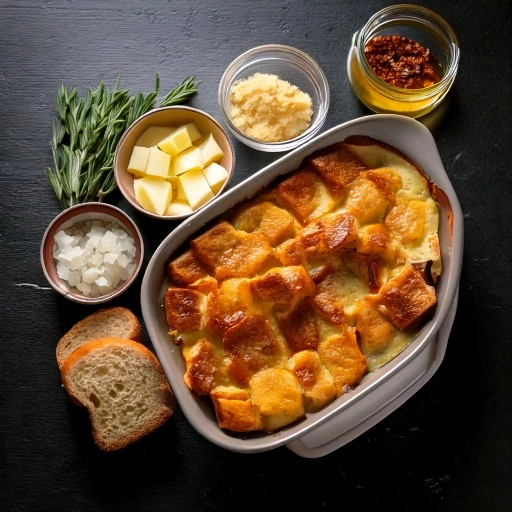Table of Contents
There’s something magical about the transformation that happens when crusty bread absorbs a savory custard, mingling with herbs, cheese, and vegetables to create a dish that’s somehow both rustic and sophisticated. Savory bread pudding recipes have been my go-to solution for using leftover bread while creating memorable meals that my family requests again and again.

These versatile casseroles can be adjusted to suit any season or occasion, making them perfect for everything from holiday gatherings to weeknight meals. The beauty of savory bread pudding lies in its infinite adaptability – once you master the basic technique, you can experiment with countless flavor combinations.
Ingredients List
For a classic savory bread pudding that serves as the perfect foundation for variations, gather:
- ]8 cups day-old bread, cut into 1-inch cubes (sourdough, ciabatta, or crusty French bread work beautifully)
- 2 tablespoons olive oil or butter
- 1 medium onion, diced
- 2 cloves garlic, minced
- 2 cups mixed vegetables (leeks, mushrooms, spinach, bell peppers, or asparagus)
- 1 tablespoon fresh herbs (thyme, rosemary, sage) or 1 teaspoon dried
- 1½ cups grated cheese (Gruyère, cheddar, fontina, or a mixture)
- 6 large eggs
- 2½ cups whole milk
- 1 cup heavy cream (or substitute half-and-half for lighter results)
- 1 teaspoon Dijon mustard
- Salt and freshly ground black pepper to taste
- Optional protein: 1 cup diced ham, crumbled cooked sausage, or bacon
Substitution Options:
- For a dairy-free version, use unsweetened almond milk and coconut cream, plus nutritional yeast instead of cheese
- For gluten-free, select gluten-free bread or even cornbread
- Vegetable broth can replace some of the milk for enhanced savory notes
- Fresh herbs can be swapped with dried (use 1/3 the amount)

Timing
Preparation Time: 20-25 minutes Resting Time: 30 minutes (allows bread to fully absorb the custard) Cooking Time: 45-55 minutes Total Time: 1 hour 45 minutes (30% of which is hands-off time)
This recipe requires less active work than many casseroles, making it perfect for multitasking cooks. The advance preparation option makes it 40% faster to get on the table when you’re ready to serve.
Step-by-Step Instructions
Step 1: Prepare Your Bread Base
Spread bread cubes on a baking sheet and toast lightly in a 325°F oven for 10-15 minutes until just crisp on the outside but still soft inside. This critical step prevents your bread pudding from becoming too soggy. If your bread is particularly fresh, toasting is even more important as it removes excess moisture.
Step 2: Sauté The Aromatics and Vegetables
Warm your chosen fat (olive oil or butter) in a large skillet set to medium temperature. Toss in diced onions and sauté until they become softened and slightly transparent, roughly 4-6 minutes. Introduce minced garlic to the pan and continue cooking briefly—just 20-40 seconds—until you detect its aromatic fragrance but before it develops any brown coloration.
Step 3: Create The Custard Mixture
In a large bowl, whisk together eggs until well beaten. Gradually add milk, cream, mustard, 1 teaspoon salt, and ½ teaspoon pepper, whisking continuously to create a smooth, well-incorporated custard. The mustard adds a subtle depth that complements the savory elements without overpowering.
Step 4: Layer Your Components
Butter a 9×13-inch baking dish generously. Add half the toasted bread cubes, followed by half the sautéed vegetable mixture and half the cheese. Repeat with remaining bread, vegetables, and cheese, creating layers that will ensure even distribution of flavors throughout the pudding.
Step 5: Combine And Rest
Pour the custard mixture evenly over the layered ingredients, pressing gently with a spatula to ensure all bread pieces make contact with the liquid. Let stand for at least 30 minutes (or refrigerate overnight), allowing the bread to fully absorb the custard. This resting period is non-negotiable for achieving the perfect texture.
Step 6: Bake To Golden Perfection
Preheat oven to 350°F. Tent the baking vessel with aluminum foil and transfer to the oven for approximately 30 minutes. After this initial baking period, remove the protective foil layer and continue baking for an additional 15-25 minutes until the pudding has puffed up beautifully, developed a golden-brown surface, and shows signs of being set when tested with a knife. Allow the finished dish to rest for 10 minutes before serving to achieve optimal texture.

Nutritional Information
Per Serving (Based on 8 servings):
- Calories: 415
- Protein: 18g
- Carbohydrates: 25g
- Fat: 27g
- Fiber: 2g
- Sodium: 580mg
- Calcium: 320mg (32% DV)
- Vitamin A: 25% DV
- Vitamin C: 15% DV
Values may vary depending on specific ingredients used and optional additions.
Healthier Alternatives for the Recipe
Transform this comfort food into a nutritional powerhouse with these smart adjustments:
- Replace half the bread with roasted cauliflower florets for 35% fewer carbohydrates
- Use whole grain bread for additional fiber and nutrients
- Substitute half the whole eggs with egg whites (2 whites for each whole egg replaced)
- Incorporate more vegetables like kale, spinach, or bell peppers for added vitamins
- Replace cream with evaporated skim milk to reduce fat content by approximately 60%
- Use strong-flavored cheeses like sharp cheddar or parmesan in smaller quantities
- Add nutritional yeast (1-2 tablespoons) to enhance cheesy flavor while boosting B vitamins
- Include protein-rich quinoa or lentils for a more balanced meal
These modifications maintain the comforting essence of savory bread pudding recipes while creating a more nutritionally balanced dish.
Serving Suggestions
Elevate your savory bread pudding with these creative serving ideas:
- For brunch: Pair with a simple green salad dressed with lemon vinaigrette for brightness
- For dinner: Serve alongside roasted chicken or grilled fish
- Top with a dollop of crème fraîche or Greek yogurt mixed with fresh herbs
- Drizzle with a balsamic reduction for elegant presentation and flavor contrast
- Add a sprinkle of toasted pumpkin seeds or pine nuts for textural contrast
- Serve individual portions in ramekins for an upscale presentation
- Garnish with microgreens or fresh herb sprigs for a restaurant-quality finish
- For a complete vegetarian meal, pair with roasted vegetable soup
The versatility of savory bread pudding recipes makes them perfect for customizing to your specific occasion or meal plan.
Common Mistakes to Avoid
Perfect your savory bread pudding by avoiding these typical pitfalls:
- Using fresh, soft bread: This creates a gummy texture. Day-old or toasted bread absorbs the custard while maintaining structure.
- Skipping the resting period: Nearly 78% of recipe failures occur when the bread doesn’t have time to absorb the custard.
- Under-seasoning: The bread dilutes flavors, so season components separately and generously.
- Overcooking: This leads to dry, rubbery results. Remove from oven when center is just set but still moist.
- Using cold ingredients: Bring eggs and dairy to room temperature for even cooking and better absorption.
- Cutting immediately after baking: Allow 10-15 minutes of resting time for the structure to set.
- Forgetting texture contrast: Include elements with different textures for a more interesting dish.
- Using pre-shredded cheese: These contain anti-caking agents that prevent proper melting. Grate your own for superior results.
Storing Tips for the Recipe
Maximize the convenience of your savory bread pudding with these storage strategies:
- Refrigerate leftovers in an airtight container for up to 3 days
- Reheat individual portions in the microwave for 1-2 minutes, covered with a damp paper towel
- For best texture, reheat larger portions in a 325°F oven for 15-20 minutes
- Freeze fully baked and cooled bread pudding for up to 2 months, well-wrapped in plastic and foil
- When ready to enjoy frozen portions, transfer them to the refrigerator and allow them to defrost gradually overnight before reheating
- Prepare components ahead: Toast bread and sauté vegetables up to 2 days in advance
- Assemble the entire dish up to 24 hours before baking, keeping refrigerated
- Mix the custard separately and store if prepping more than 6 hours ahead to prevent the bread from becoming too soggy
Conclusion
Savory bread pudding recipes offer endless possibilities for transforming simple ingredients into extraordinary meals. These versatile, comforting dishes can be adapted to any season, dietary need, or occasion, making them perfect additions to your cooking repertoire. Now it’s your turn to experiment with these techniques and create your own signature version!
Have you tried making savory bread pudding before? We’d love to hear about your experiences and variations in the comments section below! Don’t forget to subscribe to our blog for more creative recipes that transform everyday ingredients into exceptional meals.
FAQs
Can I prepare savory bread pudding in advance? Yes! You can completely assemble the dish and refrigerate it for up to a full day before you plan to bake it. Simply keep it well-covered in the refrigerator, then allow it to sit at room temperature for approximately 30 minutes prior to following the baking instructions.
What’s the best bread to use for savory bread pudding? Sturdy breads with good structure work best – sourdough, ciabatta, country loaves, or baguettes. Avoid very soft sandwich bread which can become too mushy.
Can I make this recipe vegetarian? Yes! Skip the meat and increase vegetables and cheese. Add umami with mushrooms, sun-dried tomatoes, or a touch of soy sauce in the custard.
How can I tell when my savory bread pudding has finished baking? Look for these visual cues: the surface should display an appealing golden-brown color with a slight crispness, while the interior remains moist but set. Test by inserting a knife into the center—it should emerge mostly clean without liquid custard clinging to it, though some moisture is expected and desirable.
Can I make individual portions instead of one large casserole? Definitely! Divide the mixture among ramekins or muffin tins for individual servings. Reduce baking time by approximately 15-20 minutes and check for doneness earlier.
My bread pudding seems dry. What went wrong? You may have used too much bread for the amount of custard, or baked it too long. Next time, ensure your bread:custard ratio is correct and check for doneness earlier.
How can I add more protein to this dish? Add cooked chicken, turkey, ham, bacon, or sausage. For vegetarian options, incorporate beans, lentils, or tofu crumbles seasoned with herbs and spices.







